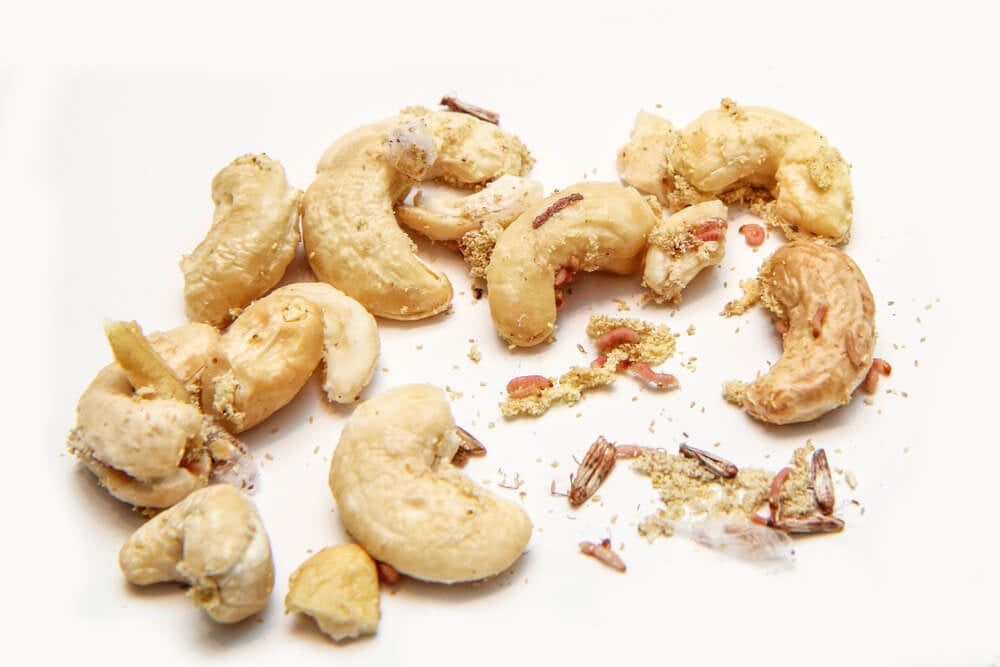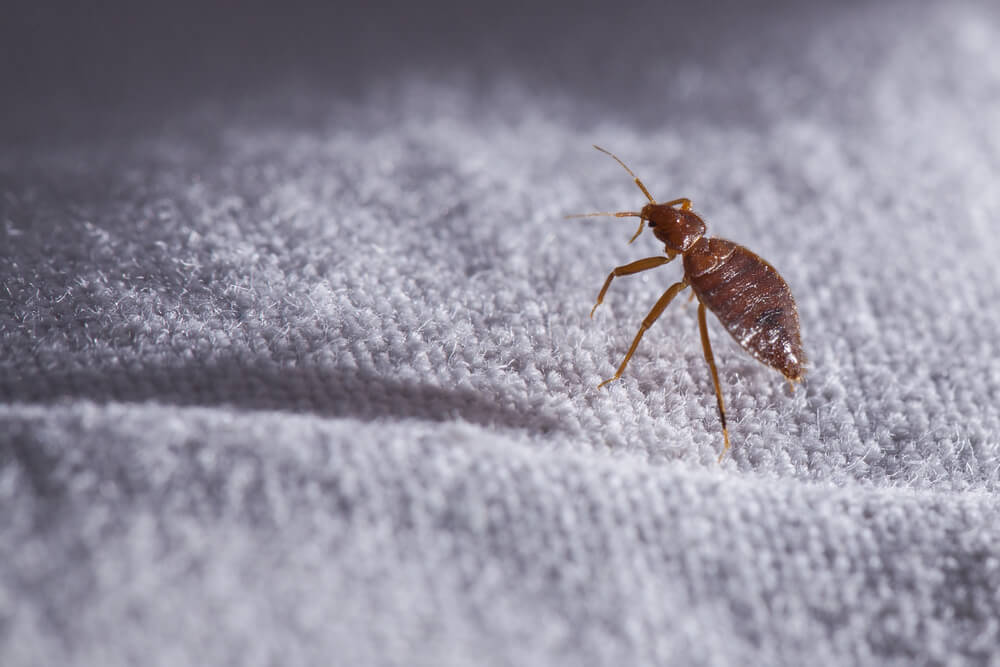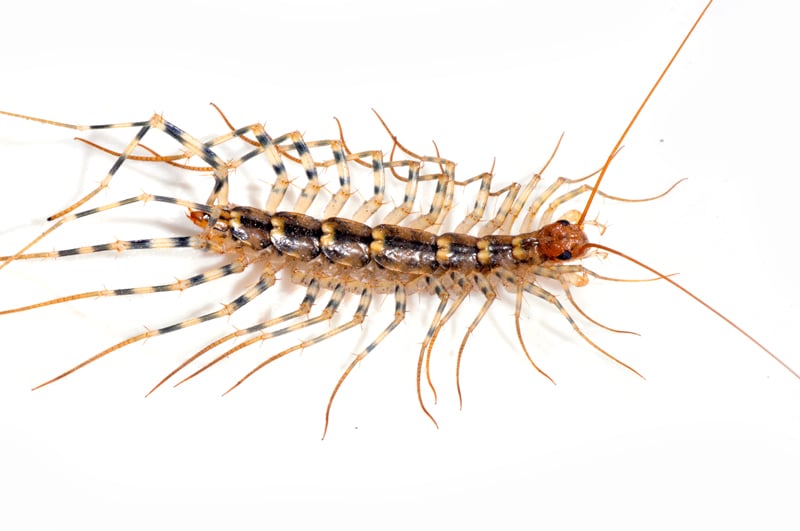What It Was
 In all likelihood, the pest you just had the misfortune of encountering was an Indian meal moth (Plodia interpunctella). This species of moth is one of the most common stored food pests in the United States. The Indian meal moth undergoes four stages of development during its life cycle: egg, larva, pupa, and adult. Unfortunately, if you encountered an adult moth in your pantry, it probably developed through all four stages there.
Adult Indian meal moths have a wingspan of around ¾ inches. Their wings have distinctive lustrous, red-brown markings on the outer two-thirds and turn white-grey on the inner thirds. Indian meal moth larvae are ½ an inch long, translucent pale white or yellow, and have brown heads. Larvae spin white silken threads as they move, and eventually use these threads to build their pupal cocoon. These cocoons are usually pale brown. Indian meal moth eggs are milky white and so small they’re difficult to see.
In all likelihood, the pest you just had the misfortune of encountering was an Indian meal moth (Plodia interpunctella). This species of moth is one of the most common stored food pests in the United States. The Indian meal moth undergoes four stages of development during its life cycle: egg, larva, pupa, and adult. Unfortunately, if you encountered an adult moth in your pantry, it probably developed through all four stages there.
Adult Indian meal moths have a wingspan of around ¾ inches. Their wings have distinctive lustrous, red-brown markings on the outer two-thirds and turn white-grey on the inner thirds. Indian meal moth larvae are ½ an inch long, translucent pale white or yellow, and have brown heads. Larvae spin white silken threads as they move, and eventually use these threads to build their pupal cocoon. These cocoons are usually pale brown. Indian meal moth eggs are milky white and so small they’re difficult to see.
What It Wants
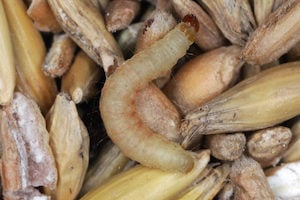 Adult Indian meal moths live for literally one thing: reproducing. They don’t even eat! Unfortunately, however, adult meal moths aren’t your only concern. Indian meal moths seek out stored food in order to lay their eggs on it. Adult Indian meal moths lay 100 to 300 eggs in their short lifetimes. They spread these eggs in pod-like groupings over dry food materials.
When these eggs hatch, meal moth larvae, or caterpillars, start munching down on food immediately. They dig into grains, corn meal, cereals, flour, dried fruit, nuts, popcorn, spices, and several other pantry staples. Meal moths remain near their food sources throughout their lifespan, so they can eat as larvae and reproduce as adults. Often, larvae preparing to pupate will climb onto ceilings or wall corners before they build their cocoons. Pupation occurs quickly, and new adult Indian meal moths are ready to mate immediately.
Adult Indian meal moths live for literally one thing: reproducing. They don’t even eat! Unfortunately, however, adult meal moths aren’t your only concern. Indian meal moths seek out stored food in order to lay their eggs on it. Adult Indian meal moths lay 100 to 300 eggs in their short lifetimes. They spread these eggs in pod-like groupings over dry food materials.
When these eggs hatch, meal moth larvae, or caterpillars, start munching down on food immediately. They dig into grains, corn meal, cereals, flour, dried fruit, nuts, popcorn, spices, and several other pantry staples. Meal moths remain near their food sources throughout their lifespan, so they can eat as larvae and reproduce as adults. Often, larvae preparing to pupate will climb onto ceilings or wall corners before they build their cocoons. Pupation occurs quickly, and new adult Indian meal moths are ready to mate immediately.
Why Your Pantry?
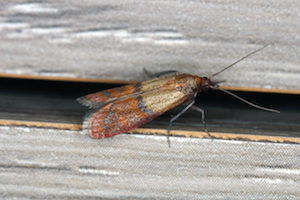 The rate at which the moths develop through their life stages is determined by their environment. Meal moths require two things to develop as quickly as possible: consistent warmth and consistent food. Indian meal moths require temperatures of at least 50℉ to survive and reproduce. To grow and reproduce quickly, they need more warmth and a consistent food source for their larvae. Chances are, your pantry easily satisfies both requirements.
The more warmth and food Indian meal moths have, the faster they can complete their life cycles. In the right conditions, a generation of meal moths can cycle from egg to adult in as few as 28 days. The faster a single cycle completes, the sooner another cycle happens. The sooner another cycle happens, the more moths you’ll have to contend with. Indian meal moths seek out pantries where they can easily and safety access the things they need to thrive. That means they’re after darkness, seclusion, large quantities of accessible food, and warmth.
The rate at which the moths develop through their life stages is determined by their environment. Meal moths require two things to develop as quickly as possible: consistent warmth and consistent food. Indian meal moths require temperatures of at least 50℉ to survive and reproduce. To grow and reproduce quickly, they need more warmth and a consistent food source for their larvae. Chances are, your pantry easily satisfies both requirements.
The more warmth and food Indian meal moths have, the faster they can complete their life cycles. In the right conditions, a generation of meal moths can cycle from egg to adult in as few as 28 days. The faster a single cycle completes, the sooner another cycle happens. The sooner another cycle happens, the more moths you’ll have to contend with. Indian meal moths seek out pantries where they can easily and safety access the things they need to thrive. That means they’re after darkness, seclusion, large quantities of accessible food, and warmth.
What to Do Now
 First: breathe. It’s going to be ok! If you’re reading this late at night after a close encounter of the gross kind, go to sleep! Indian meal moths are not dangerous. That doesn’t mean you should let them be, however. Indian meal moths can ruin a surprising amount of food quite quickly. They eat it and soil it with their eggs, waste, and silk. You don’t want to eat Indian meal moth eggs. That’s just nasty.
Take all the food that Indian meal moths could infest out of your pantry. Throw out anything you can part with, and inspect the rest very carefully. Take garbage to the outdoor dumpster directly. Thoroughly clean out and scrub down your pantry. Make sure to get the shelves, corners, ceilings, and containers. Keep food in sealable, airtight plastic. Make sure you sweep or vacuum up crumbs quickly. Once you find and remove all the eggs, you’ll have gone a long way toward wiping out the infestation.
The last thing you need to know about pantry moth infestations: you don’t have to fight them yourself. Next time you’re surprised by a moth in your pantry, give Plunkett’s Pest Control a call right away. We’re always happy to help you reclaim your midnight snacking time.
First: breathe. It’s going to be ok! If you’re reading this late at night after a close encounter of the gross kind, go to sleep! Indian meal moths are not dangerous. That doesn’t mean you should let them be, however. Indian meal moths can ruin a surprising amount of food quite quickly. They eat it and soil it with their eggs, waste, and silk. You don’t want to eat Indian meal moth eggs. That’s just nasty.
Take all the food that Indian meal moths could infest out of your pantry. Throw out anything you can part with, and inspect the rest very carefully. Take garbage to the outdoor dumpster directly. Thoroughly clean out and scrub down your pantry. Make sure to get the shelves, corners, ceilings, and containers. Keep food in sealable, airtight plastic. Make sure you sweep or vacuum up crumbs quickly. Once you find and remove all the eggs, you’ll have gone a long way toward wiping out the infestation.
The last thing you need to know about pantry moth infestations: you don’t have to fight them yourself. Next time you’re surprised by a moth in your pantry, give Plunkett’s Pest Control a call right away. We’re always happy to help you reclaim your midnight snacking time.

